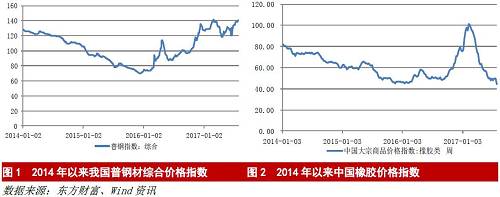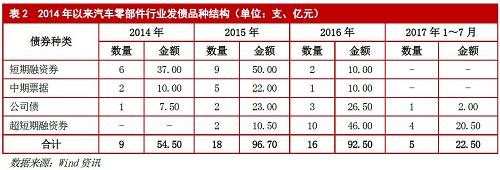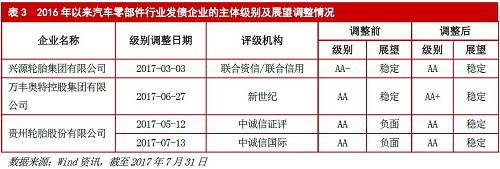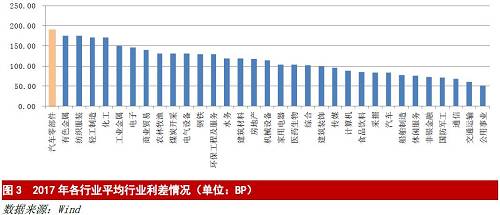Industry Credit Risk Outlook: Medium industry The prosperity of the auto parts industry in 2016 partially overdrawn the demand for small-displacement passenger cars in the first half of 2017, reflecting the decline in the sales growth rate of small-displacement passenger cars; however, it was driven by factors such as highway restrictions and environmental protection. Commercial vehicle sales have remained strong. Bond market In the first half of 2017, the scale of debt issuance of the auto parts industry has declined year-on-year, the term structure has become short-term, the maturity structure of assets and liabilities has not matched or led to increased liquidity risk; auto parts companies have two levels up, and overall credit qualifications are relatively high. stable. enterprise Fuyao Glass (600660, stock bar) and other corporate mergers and acquisitions and globalization continue to advance; since 2017, the main business of Guizhou Tyre Co., Ltd. has continued to suffer losses, and operating profit mainly comes from relocation compensation and non-operating income; Sanhuan Group (300408 , Shares) The gross margin of the main products showed a downward trend. Outlook With the decline in commodity prices, it is expected that the cost of auto parts companies will decline in the second half of 2017, and the wealth creation capacity will increase. The outlook for the auto parts industry will remain stable. I. Industry Development Since 2017, due to the impact of the previous automobile purchase tax halving overdraft passenger demand, passenger car consumption has declined, but the road traffic control policy has continued, resulting in an increase in sales of commercial vehicles. The auto parts industry is a strong cyclical industry, and macroeconomic trends determine the degree of industry prosperity. From 2006 to 2015, the compound annual growth rate of China's auto sales was 14.59%. Since 2009, China's auto sales have ranked first in the world for many consecutive years. The per capita possession of cars in China is relatively low. With the increase in per capita disposable income, the consumption of automobiles, especially in the central and western regions, still has some room for growth. From 2001 to 2015, the compound annual growth rate of sales revenue of China's auto parts industry was 25.67%, which was higher than the compound growth rate of auto industry sales revenue of 18.28% over the same period. The proportion of the industry’s total output value in the auto industry also continued to grow, but relative to The level of 60-70% in developed countries is still low. Judging from the structure of the auto market, the domestic parts and components industry is facing a bright future. In 2016, due to factors such as the upgrading of consumption structure, reduction of purchase tax for passenger vehicles, and the policy of supervising highways, the automobile industry enjoyed a significant improvement. The domestic automobile production and sales volume was 28,128,800 and 2,802.82, respectively, which was a year-on-year increase of 14.46. % and 13.65%, the growth rate increased by 11.21 percentage points and 8.97 percentage points year-on-year respectively; the average sales growth rate of auto parts and accessories manufacturing enterprises rose from 0.3% in 2015 to 13.50% in 2016, and the ROE remained relatively It is stable, with 9.80% and 9.90% in 2015 and 2016, respectively. From January to June 2017, the domestic automobile sales increased by 4.28% year-on-year, the independent brand performance was strong, and the market share increased. Among them, the policy of overdraft demand for small- The year-on-year growth of vehicle sales slowed down to 2.14 percent; and due to the lack of capacity and product update cycle due to the “super cure†policy on highways, commercial vehicle sales rose 17.46% year-on-year. It is expected that in the second half of the year, as the advent of the automotive sales season and the end of the purchase tax preferential policies, passenger car sales will pick up, and commercial vehicle sales will continue to maintain its strong momentum. The price of raw materials is affected by the trend of commodity prices. The fluctuations affect the profitability and production stability of auto parts companies. The upstream of auto parts is mainly steel, rubber, plastics, and other fabrics. The prices of raw materials are ultimately affected by bulk commodities such as steel, natural rubber, and petroleum. In terms of steel, steel prices have oscillated upward since 2016. In terms of rubber, after experiencing significant growth in the second half of 2016, rubber prices fell sharply in February 2017. On the oil front, due to the slowdown in global economic growth, abundant oil supply but weak demand, international crude oil prices fell rapidly in the second half of 2014. In 2015, WIT crude oil prices fell to around US$36.70 per barrel. In 2016, Affected by the closing of oil fields by Nigerian armed conflicts, OPEC and other oil-producing countries, the price of oil has risen by nearly 50% for the year. In the first half of 2017, international oil prices oscillated. The fluctuation of raw material prices will directly affect the profitability of auto parts products and the operating stability of production companies. There is fierce competition among domestic parts and components companies and deepening of domestic substitution; however, China's auto parts manufacturing industry is relatively small, and it is in a weak position in terms of core technology. A car consists of about 1 to 30,000 parts and components, and the parts and components industry, as the upstream industry of the vehicle, is the basis for the development of the automobile industry. Traditional automotive components include engine assemblies, clutch assemblies, transmission assemblies, steering systems, suspension systems, interior and exterior trims, automotive tires, and brake systems. Emerging components include power batteries and drive motors. China's auto parts industry started relatively late. Compared with foreign companies, it has a smaller scale. Compared with automakers in Europe, America and Japan, there are still large gaps in the ability of independent innovation and mastery of core technologies. At present, China’s auto parts products have been imported and imported from products with low value-added products, such as glass, tires, and car lights. At the same time, some companies have begun to enter high-value-added products through mergers and acquisitions, technology research and development. With the continuous growth of auto brands, the auto parts products will also achieve both quality and quantity. The downstream areas of the auto parts industry are divided according to their use, mainly supporting the OEM market and the after-sales service market (AM). The downstream customers of auto parts are mainly domestic and foreign automakers and their component suppliers, and their customers are highly concentrated. Therefore, parts and components companies are in a relatively weak position. However, for some parts suppliers with leading edge in a certain market segment, their market position and technological advantages will help to increase market discourse power and bargaining power. In recent years, although the sales of domestic automobiles have been steadily increasing, the prices of complete vehicles have been declining. Auto parts manufacturers are in a weak position relative to mainframe factories, and it is difficult to resist the pressure of price cuts passed on by OEMs. Since 2017, various ministries and commissions have issued various policies to support the development of the auto parts industry; energy saving and environmental protection technologies will become the future development trend of auto parts and components. On August 18, 2016, the four ministries and commissions including the Ministry of Transport jointly issued the Opinions on Further Improving the Illegal Refitting of Freight Cars and Overload Restriction Work, and agreed that the standards for overtaking and overloading of highway trucks should be recognized. On February 4, 2017, the National Development and Reform Commission released the Catalogue of Guidance for Strategic Emerging Industries Key Products and Services, involving a total of 8 auto parts products, including automotive electronics, new energy motors and control systems, and new energy automotive accessories. , plug-in hybrid engine, energy recovery system, fuel cells and materials, auto parts remanufacturing and 3D printing; on March 1, the Ministry of Industry and Information Technology and other four ministries issued the “Action Plan to Promote the Development of Automotive Power Battery Industry†Notice. The development of automotive power battery industry, clear tasks and measures, will help accelerate the improvement of power battery product performance and quality, and promote the sustainable development of new energy vehicles; April 25, the Ministry of Industry and Information Technology, Development and Reform Commission, Ministry of Science and Technology jointly issued the "Automobile Industry "Mid-term and long-term development plan" proposes using new energy vehicles and intelligent grid-linked vehicles as breakthroughs, accelerating cross-border integration, building a new type of industrial ecosystem, stimulating industrial transformation and upgrading, and realizing development from large to strong. With the increasing attention of the whole society to environmental issues, the energy-saving and environmental protection technologies of automobiles will become the future technological trends in the automobile and auto parts industries. Among them, lightweight technology is one of the important considerations for energy saving. The application of lightweight materials such as ultra-high-strength steels, aluminum alloys, and carbon fiber has become the development direction of the production processes of auto parts suppliers. Overall, new energy vehicles are accelerating their development. Lightweight, electronic and intelligent design of auto parts are gradually being applied. New energy-saving and environmental protection technologies will become the commanding heights of the future auto parts industry competition. Second, the bond market performance (a) financing situation From January to July 2017, the issuance volume of auto parts companies decreased by 50% year-on-year, and a total of 5 branches were issued, a year-on-year decrease of 4 branches. The total issuance amounted to 2.25 billion yuan, a year-on-year decrease of 2.95 billion yuan, a sharp drop. The characteristics of bond issuance and level adjustment are as follows. Since 2017, the amount and amount of bonds issued by the auto parts industry have decreased year-on-year. The term structure of bonds tends to be short-term, which easily leads to mismatch of asset and liability maturity structures and increased liquidity risk. From the perspective of bond issuance, from 2014 to 2016, the number of bonds issued by the auto parts industry fluctuates. In 2015, the number of bonds issued by the auto parts industry was 18, and the scale of issuing bonds was 9.67 billion yuan, which was a year-on-year increase. In 2016, the number of bonds issued and the scale of bond issuance decreased. From January to July 2017, the amount and amount of bonds issued by the auto parts industry all dropped significantly year-on-year. Judging from the variety of bonds, from 2014 to 2015, the bond financing period of the auto parts industry was mainly short-term, and the proportion of long-term bonds increased. Since 2016, industry bonds have become short-term, and the proportion of ultra-short-term financing bills has increased year by year. . (II) Level changes Since 2017, there are only 3 auto parts issuing companies, and the credit qualification of debt-issuing enterprises has remained stable overall From the point of view of bond issuers, from 2014 to 2016 and from January to July 2017, there were a total of 16 bond issuers in the auto parts industry, with a relatively high level of focus. Among them, Fuyao Glass Industry Co., Ltd. The month is increased to AAA, Wanan Group Co., Ltd. is rated A+, Xingyuan Tire Group Co., Ltd. is AA-, and Northern Lingyun Industry Group Co., Ltd. is AA+. In addition, the auto parts industry has all The debt principal level is all AA. Due to the disadvantaged status in the industry chain, the auto parts industry has the characteristics of long receivables collection cycle. The short-term maturity structure of bonds may lead to the mismatch of asset and liability maturity structures and increase liquidity risk. As of the end of July 2017, the auto parts industry grade and outlook adjustment of the company for the Hing Yuen Tire Group Co., Ltd. from the AA-/ stability of the joint credit information to adjust the AA / stability of the credit; Wanfeng Auto Group Holding Co., Ltd. by AA / Stable adjustment to AA+/stability, mainly due to the company's 2016 main business development status, significant increase in operating income and profit, continuous net inflow of operating cash flow, and the company’s steam turbine business orders increase year by year; Guizhou Tire The company's AA/negative adjustment has been adjusted to AA/stabilization. The reason for the outlook adjustment is that since 2016, the company's total debt and asset-liability ratio have dropped and it has been compensated for relocation losses. (III) Industry spreads Due to the tightening of liquidity, the industrial interest rate of auto parts in the first half of 2017 increased From the perspective of interest rate spread, due to the tightening of liquidity since 2017, the rate spread of auto parts issuing companies from January to June was 190.76 BP, which was a significant increase from the average spread of the industry in 2016 of 89.46 BP. Higher than the average interest rate of various industries in the same period and the overall average spread of the auto industry. From the perspective of different levels, the average spread of bonds with AA bond issue level in 2016 was 117.24BP, and the average bond spread for bond issuers with AA and ultra-short-term financing bonds was 143.77 BP. In the first half of 2017, the auto debt-issuing enterprises in the auto parts industry were all subject to AA, and all of them were ultra-short-term financing bills, and the interest spread was higher than that in 2016. As a whole, the interest rate differential in the auto parts industry is high, and due to macro liquidity, since 2017, the industry interest margin has increased. Third, pay attention to business Fuyao Glass and other corporate mergers and acquisitions and globalization continue to advance the layout Since 2016, the main features of the operation of the auto parts industry and the operation of debt-issuing companies include the following: First, changes in raw material prices have led to a drop in the gross margin of the industry. In 2016, driven by the recovery of auto sales, the operating conditions of auto parts companies have improved. At the same time, the prices of bulk commodities such as steel and rubber have continued to rise and cost pressures have increased. As a result, the overall gross profit margin of auto parts companies in the first quarter of 2017 has increased. Declined. Since February 2017, rubber prices have declined, and the overall gross margin of the industry is expected to increase in the second quarter. The second is the gradual spread of corporate mergers and acquisitions and globalization. The production line of Saiyu Jinyu (601058, Ltd.) gradually increased in Vietnam; DoubleStar acquired 42.01% of the equity of Kumho Tire Co., Ltd., and both parties can play a complementary role and have a strategic synergy; Fuyao Glass has actively expanded its overseas expansion in recent years. After acquiring the United States PPG plant in Illinois, USA, and building the world's largest auto glass factory in Moranine, Ohio, the company also said that it will invest US$1 billion to set up a plant in the United States by the end of the year. In Europe, Fuyao Glass It also stated that it will further invest 130 million U.S. dollars in Germany and Russia to promote the development of overseas high-end markets; Wan Liyang (002434 shares) will acquire Chery transmissions and enter the supply system of its own brand models; Ningbo Junsheng will be the global automotive safety system in 2016 The suppliers, US KSS, and German TS in the smart car chat area were included in the scope of consolidation, and their revenues increased significantly. Overseas expansion can achieve lower costs in some areas, and it can also avoid the negative impact of international trade friction on enterprises to some extent. At the same time, corporate mergers and acquisitions and external expansion have imposed higher requirements on their own operational management capabilities and financial strength. Once the business fails to achieve expectations, it may affect the company's own stability. Since 2017, the main business of Guizhou Tyre Co., Ltd. has continued to suffer losses, and its operating profit mainly comes from relocation compensation and non-operating income; the gross margin of major products of Sanhuan Group has declined. Guizhou Tyre Co., Ltd.'s profit from its operating business in 2017 was -0.39 billion. As it continued to receive relocation compensation of 240 million yuan, net profit turned profitable. On April 14, 2017, Guizhou Tyre Co., Ltd. received the 7th anti-dumping and anti-subsidy administrative review of the non-road tires from China issued by the US Department of Commerce, which resulted in the difficulty of exporting non-road tires to the United States market. Big. The downstream of Sanhuan Group Co., Ltd. was mainly Dongfeng Group. In 2016, the sales of Dongfeng Group increased. The revenue of Sanhuan Group Co., Ltd. increased, but the gross profit margin of its main products showed a downward trend. In addition, since 2017, China The slowdown in vehicle sales may affect its auto dealership business. Taken together, since 2017, auto parts companies have enjoyed a good profitability and have low debt repayment risk. Fourth, the second half of the outlook In the short term, with the advent of the auto sales season in the second half of the year, the last-ditch effect of preferential policies for the purchase of small-displacement vehicles, and the extension of the highway restriction policy, the sales volume in the vehicle market will increase, which will drive upstream auto parts. Corporate sales increase. With the decision of the “double reverse†final ruling in 2017, China’s future passenger car tires that are exported to the United States will no longer be subject to anti-dumping and countervailing duties, and it is expected that China’s tire export volume will resume growth. In the future, the auto parts industry will continue to maintain a certain level of demand for a long period of time. The decline in the prices of upstream rubber and other commodities can ease the cost pressure. It is expected that the gross margin of the industry will rebound in the second half of the year and a good debt repayment environment will help protect the industry. The stability of internal corporate wealth creation and debt repayment ability. Therefore, Dagong's outlook for the auto parts industry remains stable. China Home Ev Charger ,Wall-Mounted Ac Ev Charging Station manufacturer, choose the high quality Wall-Mounted Ac Ev Charger,Wall-Mounted Ac Ev Charging Pile, etc. Home Ev Charger,Wall-Mounted Ac Ev Charging Station,Wall-Mounted Ac Ev Charger,Wall-Mounted Ac Ev Charging Pile Shenzhen Hongjiali New Energy Co., Ltd. , https://www.hjlcharger.com




Auto Parts Industry Credit Risk Report